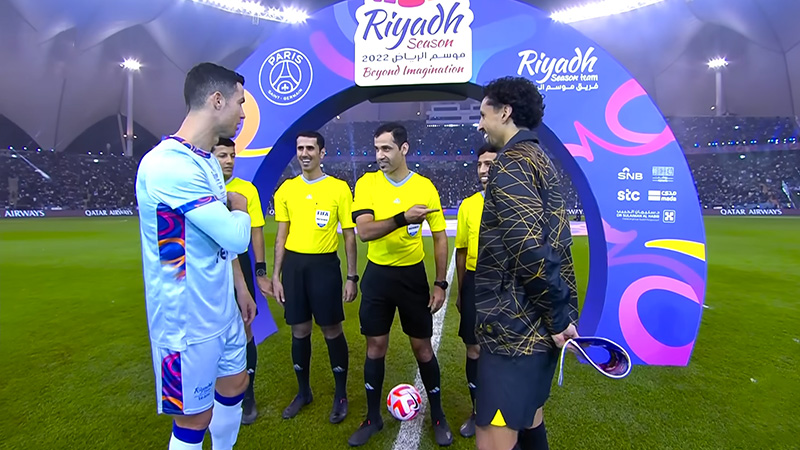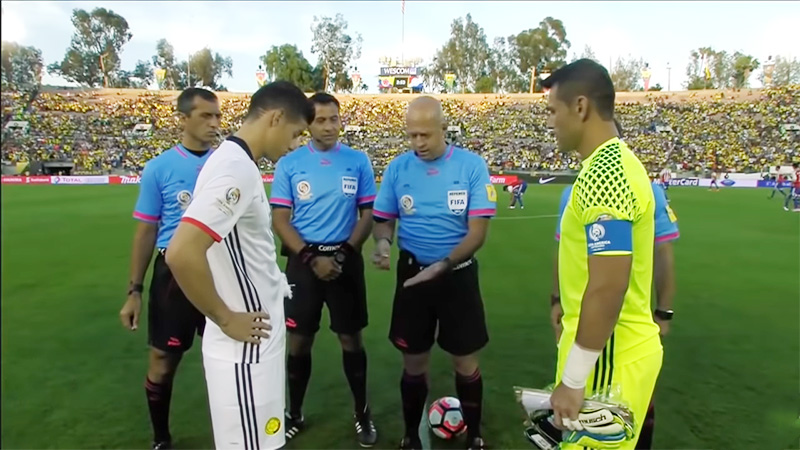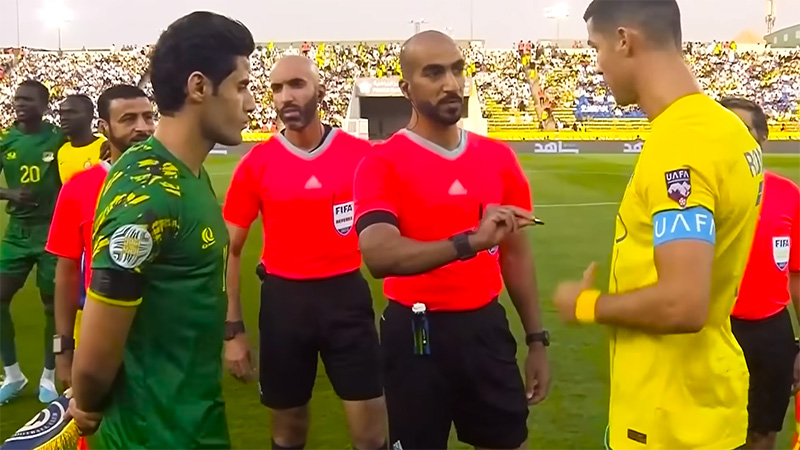The game of soccer, cherished for its simplicity and passion, is not without its rituals and traditions. Among these, the coin toss before kickoff holds a special place.
The Soccer Coin Toss Rules form an integral part of the pre-match proceedings, dictating critical aspects of the game such as kickoff and field orientation.
As team captains gather at the center of the field with the match referee, the coin toss determines which team gains the initial advantage and sets the tone for the match.
The visiting team captain plays a pivotal role, making the call as the coin spins in the air. The outcomes of the toss, whether it’s kickoff or end selection, carry strategic implications, shaping the teams’ strategies and mindsets from the very outset.
This article delves into the intricacies of Soccer Coin Toss Rules, shedding light on how this simple yet significant tradition impacts the dynamics of soccer matches.
Soccer Coin Toss Rules
Soccer coin toss rules are an essential part of the pre-match proceedings, helping to determine various aspects of the game, such as which team starts with possession and which end of the field they defend.
Here’s a breakdown of the soccer coin toss rules:
Captains’ Responsibilities

Before the match begins, the team captains meet with the match referee at the center of the field for the coin toss. The captains are usually chosen by their respective teams for their leadership roles and represent their squads during this crucial moment.
Coin Toss Procedure
The match referee tosses a coin, typically with one side representing “heads” and the other “tails.” The visiting team captain usually calls the toss in the air as it spins, determining which side of the coin will determine the outcome.
Decision Options
The team that wins the coin toss is given the choice of either “kickoff” or “end selection.” If they choose “kickoff,” they will start the game by taking the first kickoff.
If they opt for “end selection,” they decide which end of the field they want to attack and which end they want to defend. The team that loses the toss takes the opposite of the selected option.
Kickoff
The team that chooses to kick off starts the match with the ball at the center circle. The opposing team must be in their respective half of the field until the ball is kicked.
The match officially begins when the ball is set in motion from the kickoff.
End Selection
If a team chooses “end selection,” they decide which goal they want to attack in the first half. The other team takes the other end of the field.
At halftime, the team’s switch ends, allowing each team an equal opportunity to attack and defend under similar playing conditions.
The soccer coin toss rules are straightforward but hold significant importance in the game’s proceedings.
The outcome of the toss can influence team strategies, especially in high-stakes matches, and may impact the early dynamics of the game.
The rules ensure fairness and transparency in determining possession and field orientation, setting the stage for an exciting and competitive match.
Who Calls The Coin Toss In Soccer?

In soccer, the coin toss is a significant pre-match ritual that determines various aspects of the game, such as kickoff and end selection. The responsibility for calling the coin toss falls on the visiting team captain.
Here’s a detailed explanation of why the visiting team captain calls the coin toss:
Fairness and Courtesy
The tradition of the visiting team captain calling the coin toss is based on the principles of fairness and courtesy. In many sports, including soccer, the visiting team is considered the guest in the host team’s stadium.
Allowing the visiting captain to call the toss is a gesture of respect and hospitality, ensuring that the guest team has an equal say in the match’s starting proceedings.
Home Team’s Advantage
The home team already enjoys certain advantages, such as the support of their home crowd and familiarity with the stadium and playing conditions.
Allowing the visiting team captain to call the coin toss is a way to balance the scales, giving the guest team an element of control in the decision-making process.
Neutral Referee
To maintain impartiality, the match referee, who is responsible for conducting the coin toss, is usually neutral and not affiliated with either of the competing teams.
The referee is there to oversee the proceedings and ensure that the rules are followed correctly.
Sportsmanship and Tradition
Calling the coin toss is considered an honorable role, and it adds to the sportsmanship and tradition of the game.
The visiting team captain, representing their squad, embraces this responsibility with pride, knowing that the outcome of the coin toss can have an impact on the initial dynamics of the match.
Custom and Consistency
The practice of having the visiting team captain call the coin toss has been a longstanding custom in soccer and is consistently followed across various leagues and competitions.
This consistency in procedure contributes to the integrity and standardization of the sport.
By designating the visiting team captain as the caller of the coin toss, soccer maintains its traditions of hospitality, respect, and fairness.
It upholds the spirit of sportsmanship and provides a balance of influence in the match’s beginning, ensuring that both teams start the game on equal footing and with a shared understanding of the outcome of the toss.
When You Toss A Coin 100 Times?
When you toss a coin 100 times, several interesting observations and patterns emerge, demonstrating the principles of probability and randomness.
Here are some key points to consider:
Theoretical Probability
In a fair coin toss, where the coin is unbiased and has two equally likely outcomes (heads or tails), the theoretical probability of getting either heads or tails is 0.5 (or 50%) for each toss.
Therefore, you would expect to get approximately 50 heads and 50 tails in 100 tosses.
Law of Large Numbers
As the number of coin tosses increases, the actual results tend to converge toward the theoretical probabilities.
In a small sample like 100 tosses, you might observe some fluctuations from the expected 50-50 outcome, but as the number of tosses increases, the percentage of heads and tails would approach 50%.
Randomness
Despite the expected 50-50 probability, the actual outcomes of each individual toss are entirely random. Flipping a coin is an example of a random experiment, and the outcome of each toss is independent of the previous ones.
This means that even if you get a sequence of heads or tails in a row, the probability of getting heads or tails on the next toss remains 0.5.
Streaks and Clusters
Due to the nature of randomness, it is entirely possible to observe streaks or clusters of consecutive heads or tails during the 100 tosses.
These occurrences may seem surprising, but they are entirely consistent with the concept of probability.
Experimental Probability
When you conduct the actual experiment of tossing a coin 100 times, you will obtain a set of results. The experimental probability is the actual percentage of times a specific outcome (heads or tails) occurs in the experiment.
It may not exactly match the theoretical probability due to the small sample size, but it should be close to 50% in most cases.
Conducting a coin toss experiment with 100 tosses provides a hands-on illustration of probability concepts, showcasing the interplay between theoretical probabilities and the inherent randomness of each individual toss.
It also serves as a reminder that in random experiments, short-term variations and patterns can occur, but over a large number of trials, the law of large numbers ensures that the observed frequencies approach the expected probabilities.
FAQ
Who conducts the coin toss in soccer?
The coin toss in soccer is conducted by the match referee. Before the match begins, the team captains from both competing teams meet with the referee at the center of the field for the coin toss.
What are the options for the winning team after the coin toss?
After winning the coin toss, the team has two options to choose from: “kickoff” or “end selection.” If the team chooses “kickoff,” they will take the first kickoff from the center circle to start the match.
Can the coin toss influence the outcome of the match?
While the coin toss itself does not directly impact the gameplay or skills of the players, its outcome can influence certain aspects of the match. The team that wins the toss gets to make the initial strategic decision, such as starting with possession or selecting their preferred end.
What happens if the team captains disagree on the call during the coin toss?
In the event of a disagreement between the team captains on the call during the coin toss, the referee steps in to resolve the issue. The referee may ask the captains to repeat the toss, ensuring that the outcome is determined fairly and impartially.
Can the outcome of the coin toss be reviewed or challenged?
No, the outcome of the coin toss cannot be reviewed or challenged. The coin toss is a simple and decisive procedure conducted by the match referee, and once the result is determined, it is final and cannot be changed.
Conclusion
The Soccer Coin Toss Rules, a timeless tradition in the world of soccer, exemplify the essence of sportsmanship and fair play. As the visiting team captain calls the toss, a sense of anticipation fills the air, and the outcomes shape the narrative of the match.
The winning team’s decision, be it for kickoff or end selection, holds strategic importance, influencing the game’s early momentum and psychological dynamics.
Moreover, this ritual exemplifies respect and courtesy within soccer, ensuring that both teams have an equal say in the starting proceedings.
While the coin toss may not alter the skill or performance of the players, its significance lies in setting the groundwork for a thrilling and competitive match.
The Soccer Coin Toss Rules uphold the traditions of the sport and remind us of the simplicity and excitement that lies at the heart of this beloved game.







